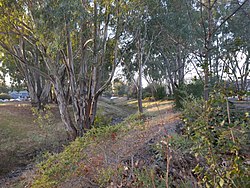Arroyo Seco is an 11.7-mile-long (18.8 km)[2] watercourse in Alameda County, California, that traverses through the city of Livermore, emptying into Arroyo Las Positas. Arroyo Seco means "dry stream" in Spanish. Arroyo Seco lies above the Arroyo Seco watershed, which includes the eastern part of the city of Livermore and also the Sandia National Laboratory. The Mocho Subbasin is the largest of the subbasins in the Livermore Valley watershed. This subbasin is bounded to the west by the Livermore Fault Zone and to the east by the Tesla Fault. Some groundwater flow occurs across these fault boundaries, but flows are discontinuous below a depth of 50 feet (15 m) across the Tesla Fault and south of the Arroyo Mocho channel across the Livermore Fault.[3] A number of threatened and endangered species reside in this watershed.[4]
| Arroyo Seco | |
|---|---|
 Arroyo Seco west of Sandia National Laboratory in Livermore | |
| Location | |
| Country | United States |
| State | California |
| Region | Alameda County |
| City | Livermore |
| Physical characteristics | |
| Source | spring |
| • location | 8 mi (10 km) southeast of Livermore |
| • coordinates | 37°39′57″N 121°36′51″W / 37.66583°N 121.61417°W[1] |
| • elevation | 1,990 ft (610 m) |
| Mouth | Arroyo Las Positas |
• location | north of Livermore |
• coordinates | 37°42′20″N 121°45′23″W / 37.70556°N 121.75639°W[1] |
• elevation | 482 ft (147 m)[1] |
See also
editReferences
edit- ^ a b c U.S. Geological Survey Geographic Names Information System: Arroyo Seco
- ^ U.S. Geological Survey. National Hydrography Dataset high-resolution flowline data. The National Map Archived 2012-03-29 at the Wayback Machine, accessed March 15, 2011
- ^ Environmental Screening Analysis, 2127 Railroad Avenue, Livermore, California, Earth Metrics rpt no. 7785, San Mateo, Ca., Feb., 1989
- ^ Lawrence Livermore National Laboratory Environmental Features
